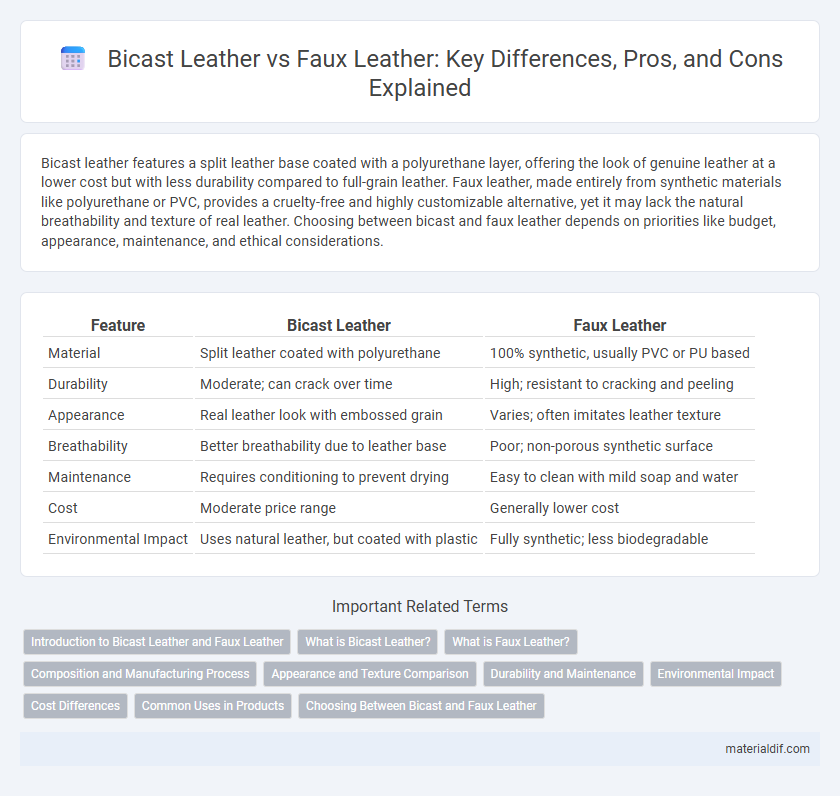Bicast leather features a split leather base coated with a polyurethane layer, offering the look of genuine leather at a lower cost but with less durability compared to full-grain leather. Faux leather, made entirely from synthetic materials like polyurethane or PVC, provides a cruelty-free and highly customizable alternative, yet it may lack the natural breathability and texture of real leather. Choosing between bicast and faux leather depends on priorities like budget, appearance, maintenance, and ethical considerations.
Table of Comparison
| Feature | Bicast Leather | Faux Leather |
|---|---|---|
| Material | Split leather coated with polyurethane | 100% synthetic, usually PVC or PU based |
| Durability | Moderate; can crack over time | High; resistant to cracking and peeling |
| Appearance | Real leather look with embossed grain | Varies; often imitates leather texture |
| Breathability | Better breathability due to leather base | Poor; non-porous synthetic surface |
| Maintenance | Requires conditioning to prevent drying | Easy to clean with mild soap and water |
| Cost | Moderate price range | Generally lower cost |
| Environmental Impact | Uses natural leather, but coated with plastic | Fully synthetic; less biodegradable |
Introduction to Bicast Leather and Faux Leather
Bicast leather features a split leather base coated with a layer of polyurethane, offering a glossy finish and increased durability compared to natural leather. Faux leather, also known as synthetic or vegan leather, is manufactured entirely from plastic materials such as polyurethane or polyvinyl chloride (PVC), mimicking the appearance of real leather without using animal hides. Both materials provide cost-effective and animal-friendly alternatives to genuine leather, with bicast leather maintaining some natural leather characteristics while faux leather emphasizes versatility and ease of maintenance.
What is Bicast Leather?
Bicast leather is a type of split leather coated with a layer of polyurethane or vinyl to create a glossy, durable surface that mimics full-grain leather. It combines a natural leather fiber base with synthetic coatings, offering a cost-effective alternative that provides a leather-like appearance and feel. Though less breathable and prone to cracking over time compared to genuine leather, bicast leather is commonly used in furniture, automotive interiors, and fashion accessories.
What is Faux Leather?
Faux leather, also known as synthetic leather, is a man-made material designed to replicate the appearance and texture of genuine leather without using animal hides. It is typically produced using a fabric base coated with polyvinyl chloride (PVC) or polyurethane (PU), offering durability, water resistance, and lower cost compared to natural leather. Commonly used in fashion, furniture, and automotive interiors, faux leather provides a cruelty-free alternative with easy maintenance but tends to have less breathability than bicast leather.
Composition and Manufacturing Process
Bicast leather consists of a split leather base coated with a layer of polyurethane, combining natural fibers with synthetic materials for durability and appearance. Faux leather, made entirely from synthetic materials such as polyurethane or polyvinyl chloride (PVC), relies on a plastic-based structure without any animal hide. The manufacturing process of bicast involves embossing the polyurethane layer onto the leather split, while faux leather is created through chemical processes that produce a fully synthetic surface.
Appearance and Texture Comparison
Bicast leather features a genuine leather base coated with a polymer layer, resulting in a glossy, smooth surface that mimics high-end leather with a slightly synthetic feel. Faux leather, made entirely from synthetic materials like polyurethane or PVC, offers a consistent texture and matte finish, often resembling genuine leather but lacking natural grain variations. Appearance-wise, bicast leather appears more polished and luxurious, while faux leather provides uniformity and durability with a softer touch.
Durability and Maintenance
Bicast leather features a split leather base coated with a layer of polyurethane, offering moderate durability but prone to cracking and peeling over time. Faux leather, made entirely from synthetic materials like PVC or PU, tends to be more resistant to stains and easier to clean, requiring minimal maintenance. While bicast leather can provide a more natural leather appearance, faux leather outperforms in maintenance efficiency and longevity under frequent use.
Environmental Impact
Bicast leather, made by layering a split leather base with a polyurethane coating, has a higher environmental impact due to the use of synthetic chemicals and non-biodegradable materials. Faux leather, typically composed of PVC or PU polymers, also contributes to pollution but can be engineered for improved recyclability and lower emissions during production. Choosing between the two depends on balancing durability with the ecological footprint of manufacturing and disposal processes.
Cost Differences
Bicast leather typically costs more than faux leather due to its partial use of genuine leather combined with a plastic coating, offering a balance between quality and affordability. Faux leather, made entirely from synthetic materials like polyurethane or PVC, is generally less expensive and suits budget-conscious consumers seeking leather alternatives. Price variations are influenced by factors such as durability, manufacturing processes, and material composition in both bicast and faux leather products.
Common Uses in Products
Bicast leather is commonly used in furniture upholstery, car interiors, and fashion accessories like handbags due to its glossy finish and durability. Faux leather, made from synthetic materials, is popular in budget-friendly clothing, shoes, and decorative items, offering water resistance and easy maintenance. Both materials are often chosen for their aesthetic appeal and cost-effectiveness compared to genuine leather in various consumer goods.
Choosing Between Bicast and Faux Leather
Choosing between bicast leather and faux leather depends on desired durability and appearance; bicast leather features a split leather base coated with polyurethane, offering a glossy finish and better breathability, while faux leather is entirely synthetic, providing higher water resistance and easier maintenance. Bicast leather tends to be more affordable than full-grain leather but can peel over time, whereas faux leather resists cracking and stains but may lack the natural texture. Consumers seeking a cost-effective option with a real leather feel may prefer bicast leather, while those prioritizing vegan materials and long-lasting protection often opt for faux leather.
Bicast Leather vs Faux Leather Infographic

 materialdif.com
materialdif.com